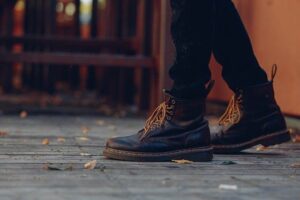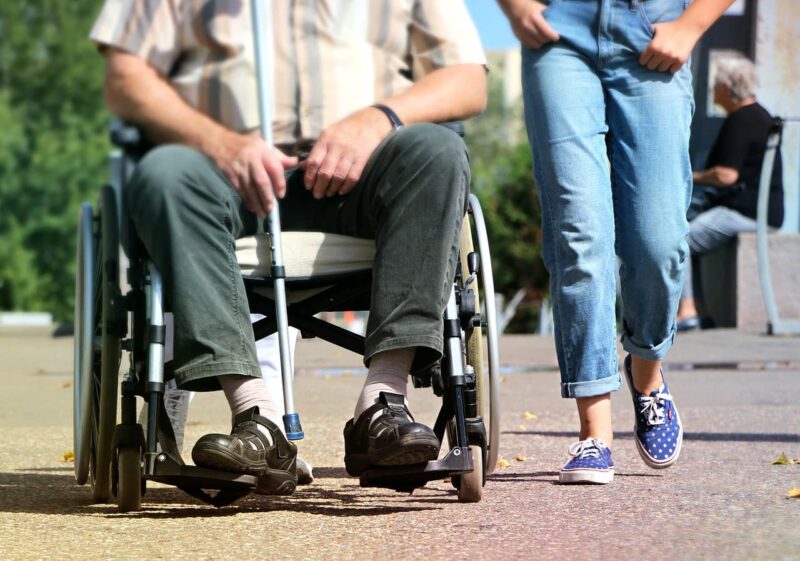Home is where the heart is. Unfortunately for seniors, it’s also where most major accidents occur. In this guide, our senior care experts discuss some of the inherent difficulties that come with senior living and provide suggestions for 8 ways to improve senior safety in the home. At guide’s end, we also provide resources on our very own senior living communities — excellent choices for San Diego seniors in need of extra care, comfort, and wanting a safe place to live.
1. Invest in Proper Apparel, Footwear, and Other Assistive Accessories
 No matter where you are, the last line of defense between you and accident or injury is your own body. Investing in the right clothing, footwear, and assistive gear (when necessary) can help you keep your body safe in the home and elsewhere. For seniors with aging bodies and health concerns, this is especially important. Wearing clothing that keeps the body comfortable and adequately warmed can help prevent illness like pneumonia, which can be devastating for seniors. Wearing properly-fitting shoes without heels can help prevent falls and keep the feet from developing bunions, hammertoes, and arthritis. Likewise, investing home-friendly, properly-measured walking aids can help prevent falls and other accidents in the home.
No matter where you are, the last line of defense between you and accident or injury is your own body. Investing in the right clothing, footwear, and assistive gear (when necessary) can help you keep your body safe in the home and elsewhere. For seniors with aging bodies and health concerns, this is especially important. Wearing clothing that keeps the body comfortable and adequately warmed can help prevent illness like pneumonia, which can be devastating for seniors. Wearing properly-fitting shoes without heels can help prevent falls and keep the feet from developing bunions, hammertoes, and arthritis. Likewise, investing home-friendly, properly-measured walking aids can help prevent falls and other accidents in the home.
2. Use Ample Lighting
Poor lighting is one of the leading causes of accident and injury in the home. Low visibility can lead to trips, falls, and a host of other unforeseen collisions that can easily be prevented by ample lighting. For seniors, many of whom struggle with diminishing eyesight or sensitive eyes, proper lighting is especially important. When it comes to home lighting for seniors, “proper” doesn’t necessarily mean bright. Overly-bright lights can lead to visibility issues and eye irritation for seniors, making them nearly as bad as inadequately low lights on the other end of the spectrum. For ideal home illumination, we recommend using only non-glare 100 watt or greater incandescent bulbs (or their fluorescent equivalents). To ensure that seniors always have light when they need it, we also recommend retrofitting easily-reachable light switches at the entrances to every room and the top and bottom of all staircases where needed.
3. Take Care of Trip Hazards
For seniors, many falls and accidents in the home occur due to the interference of everyday objects. While not every obstacle in your home can realistically be removed, there are several common trip hazards that can be partially dealt with or done away with altogether. These include:
- Scatter rugs. The corners and edges of these rugs are major trip hazards. Try tacking them down as much as possible — though the best solution is to remove the rugs altogether.
- Electrical cords. The electrical cords connected to appliances double as trip wires. Remove them from highly-trafficked areas by tucking them behind furniture or by relocating your appliances altogether.
- General clutter. Boxes, bins, hobby objects, shoes, clothing, and a host of other items can become trip hazards if not properly stored. The key is to keep them off the floor as much as possible. Utilize closets and shelves to keep clutter away from your feet and stay safe in your home.
4. Stop Slips at the Source
Next to trips, slips are one of the tops causes of accidents for seniors in their own homes. What’s the difference between trips and slips? You trip when your feet collide with another object. You slip when something underneath your feet causes you to lose balance. The main culprits behind slips include spills and slick floors. For seniors, the list of slip culprits is more numerous than it is for younger adults. This is because many seniors struggle with balance — thus, even the slightest minimization of friction can lead to major falls. To prevent accidents due to slips in the home, you’ll want to start by cleaning up any spills until your floors are spotless. Even the smallest water, oil, or other liquid spill can lead to a slip-and-fall. Speaking of spotless: clean floors are good, but overly-waxed or polished floors can be too slippery for seniors. Avoid using slippery wax or finishes on your floors. In the bathroom, it’s a good idea to skid-proof the tub and make sure your bath mat has a non-slip bottom.
5. Follow Bathroom Best-Practices
With water, smooth fixtures, and a number of other potential hazards, the bathroom presents perhaps the biggest accident risk for seniors out of all rooms in the home. Take the following steps to stay safe in your bathroom:
- To help with visibility, leave a light on in your bathroom at night or opt for plug-in night lights.
- Always use recommended bath aids. Be sure that they are securely installed on the walls of the bath/shower stall and on the sides of the toilet.
- Skid-proof your tub and invest in a bath mat with a non-skid bottom. Alternatively, add non-slip stick-and-peel applications to the bottom of the tub.
- To avoid scalds, turn your water heater to 120 degrees Fahrenheit or a cooler temperature.
- Mark your cold and hot faucets clearly.
- Use door locks that can be opened from both sides.
- If possible, bathe only when help is available.
6. Keep Your Kitchen Under Control
Bathrooms aside, kitchens are one of the most common zones for accidents in the home. By nature, kitchens contain a number of potential hazards — including large appliances, sharp and/or heavy objects, slick surfaces, and more — all of that can compromise the safety of those who use them (especially seniors). Follow these steps to stay safe in your kitchen:
- Keep your floors clean and free of clutter.
- Adequately illuminate all work areas.
- Clearly mark “on” and “off” positions on appliances.
- Store knives and other sharp object in a rack.
- Use a hot water kettle with an automatic shut-off.
- Store heavy objects at waist level.
- Keep hazardous items separate from food.
- Avoid wearing long, loose clothing when cooking.
- Make sure all food is rotated regularly, and routinely check expiration dates.
7: Mind Your Medication
The majority of seniors take at least one form of medication to deal with an ailment, injury, or chronic condition. Practicing drug safety and taking medications in the proper dosages at the right times is instrumental in maintaining medical care and well-being, both in the home and elsewhere. To ensure that you are taking your medication the right way, it’s a good idea to review your medicines frequently with your doctor or pharmacist. In your home, you’ll want to clearly label all medications you are currently taking and throw away any expired or defunct medications. Always read your medication labels in good light to ensure that you are taking the right medicine and taking the correct dose — and never borrow prescription drugs from others.
8. Consider Assisted Living
While following the above recommendations can significantly improve safety in the home, accidents can still happen. Worse, for many seniors — especially those living alone — following the above steps can prove to be difficult. Decreased physical capabilities, the onset of memory-related issues, and a host of other factors can make staying safe or in home care a challenge for many seniors. In these cases, making the move to assisted living is often the best choice.
At assisted living communities, seniors live in residences specially designed to meet their needs. Hazards are minimized as much as possible, and comfort is emphasized. Assisted living communities are also staffed with care professionals who help seniors with daily activities and work to maintain a safe and enjoyable living environment at all hours of the day. Assisted living communities give seniors a level of care and attention that often can’t be achieved in the home. In many cases, assisted living is the safest choice for seniors.

